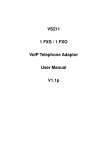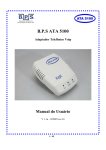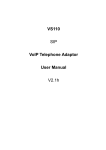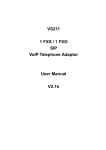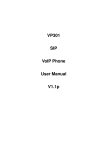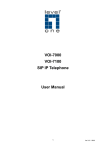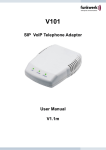Download LevelOne VOI-7010 LCD Wired handset Grey
Transcript
LevelOne VOI-7010 / VOI-7011 SIP IP Telephone User Manual Ver. 1.1 – 1008 ii Safety FCC WARNING This equipment may generate or use radio frequency energy. Changes or modifications to this equipment may cause harmful interference unless the modifications are expressly approved in the instruction manual. The user could lose the authority to operate this equipment if an unauthorized change or modification is made. This equipment has been tested and found to comply with the limits for a Class B digital device, pursuant to Part 15 of the FCC Rules. These limits are designed to provide reasonable protection against harmful interference in a residential installation. This equipment generates, uses, and can radiate radio frequency energy and, if not installed and used in accordance with the instructions, may cause harmful interference to radio communications. However, there is no guarantee that interference will not occur in a particular installation. If this equipment does cause harmful interference to radio or television reception, which can be determined by turning the equipment off and on, the user is encouraged to try to correct the interference by one or more of the following measures: 1) Reorient or relocate the receiving antenna. 2) Increase the separation between the equipment and receiver. 3) Connect the equipment into an outlet on a circuit different from that to which the receiver is connected. 4) Consult the dealer or an experienced radio/TV technician for help. CE Declaration of conformity This equipment complies with the requirements relating to electromagnetic compatibility, EN 55022 class B for ITE, the essential protection requirement of Council Directive 89/336/EEC on the approximation of the laws of the Member States relating to electromagnetic compatibility. iii Table of Contents 1. INTRODUCTION...............................................................1 1.1. 1.2. 1.3. 2. HARDWARE DESCRIPTION ...........................................5 2.1. 2.2. 2.3. 2.4. 2.5. 2.6. 3. FEATURES....................................................................2 PACKING CONTENTS .....................................................3 OPTIONAL ....................................................................3 LCD DISPLAY AND KEYPADS .........................................5 FRONT PANEL ..............................................................6 CONNECTION DIAGRAM ................................................8 INSTALLATION ...............................................................9 DEFAULT SETTING ......................................................10 RESET TO DEFAULT ....................................................10 WEB CONFIGURATION.................................................12 3.1. PHONE BOOK .............................................................14 Speed Dial Setting...........................................................16 3.2. PHONE SETTING .........................................................18 Call Forward ....................................................................19 SNTP ...............................................................................21 Volume ............................................................................22 Ringer ..............................................................................24 DND (Do Not Disturb)......................................................25 Auto Answer ....................................................................26 Dial Plan ..........................................................................28 Flash Time.......................................................................33 Call Waiting .....................................................................34 Soft-key ...........................................................................35 Hot line ............................................................................36 Alarm ...............................................................................37 3.3. NETWORK ..................................................................38 iv Network Status ................................................................39 WAN Settings ..................................................................40 LAN Settings ...................................................................42 DDNS Setting ..................................................................43 VLAN Settings .................................................................45 DMZ.................................................................................47 Virtual Server...................................................................48 PPTP ...............................................................................50 3.4. SIP SETTINGS ............................................................52 Service Domain ...............................................................54 Codec ..............................................................................58 Codec ID .........................................................................61 Other Settings .................................................................62 3.5. OTHERS .....................................................................63 Auto Config......................................................................64 FXO Port .........................................................................65 MAC Clone ......................................................................66 Tones ...............................................................................67 Advanced ........................................................................68 3.6. USER PASSWORD .......................................................70 3.7. SAVE CHANGE............................................................70 3.8. UPDATE .....................................................................71 Update Firmware.............................................................72 Auto Update Settings ......................................................74 Default Setting.................................................................75 3.9. REBOOT.....................................................................76 4. LCD DISPLAY AND KEYPAD ........................................77 4.1. 4.2. 1. 2. 3. 4. KEYPAD DESCRIPTIONS ..............................................78 LCD MENU ................................................................80 Phone Book ..........................................................80 Call History ...........................................................80 Call setting............................................................81 Network ................................................................83 v 5. 6. 7. 5. SIP Settings ..........................................................84 NAT Transversal ...................................................86 Administrator ........................................................86 APPLICATION EXAMPLE..............................................87 5.1. PSTN CALLING ..........................................................88 5.2. SIP-TO-SIP CALLING..................................................89 5.3. SIP-TO-PSTN CALLING ..............................................91 5.4. PSTN-TO-SIP CALLING ..............................................93 5.5. 3-WAY CONFERENCE CALLING ....................................95 5.6. DIRECT IP TO DIRECT IP CALLING ...............................97 5.7. FREEW ORLD DIALUP (FWD) ......................................98 SIP Settings.....................................................................99 Codec Setting................................................................100 6. SPECIFICATION ...........................................................101 7. TROUBLE SHOOTING.................................................103 7.1. 7.2. DO NOT HEAR DIAL TONE?.........................................103 CAN NOT ACCESS WEB PAGE? ...................................103 vi 1. Introduction The VOI-7010 / VOI-7011 IP Phone are an LCD VoIP Phone with SIP Protocols for Voice over IP (VoIP) applications. IP Phone can make a VoIP call over the ADSL Internet connection, and it provides one RJ45 WAN port for ADSL Internet connections plus one RJ45 LAN port for Notebook PC connection. With the embedded NAT/DHCP server, IP Phone can be easily configured for different network diagrams by PC Web browser and telephone keypads. This is very suitable for ITSP (Internet Telephony Service Providers) and SOHO users to make VoIP calls. Moreover, with PPTP VPN client supported, user can create secured tunnel between central office and IP Phone, make sure your communication is safe. VOI-7011 provides one FXO port to connect to traditional telephone line, it allows forwarding calls from traditional telephone line to VoIP, or vice versa. 1 1.1. Features SIP v1 (RFC2543), v2 (RFC3261) with MD5 authentication (RFC2069 and RFC 2617) RJ45 x 2 for Ethernet WAN and LAN ports ITU-T G.711, G.723, G.726, G.729A/B, VAD and CNG for Speech Codec ITU-T G.165/168 Echo Cancellation LCD Display for registered IP phone number Configurations by Web Browser and Telephone Keypads Embedded NAT/DHCP Server PPPoE/DHCP Client for Dynamic IP plus NAT, DNS, and DDNS Clients Support STUN server for NAT Traversal Speed Dial, Call Forward/Waiting/Transfer/Hold, and 3-Way Conference Call features Direct IP/URL Dial without SIP Proxy or Dial number via SIP server Phone book stores up to 140 records VPN PPTP Client embedded One FXO port to forwarding calls * * Only VOI-7011 provides FXO port 2 1.2. Packing Contents Open the shipping cartons of the Switch and carefully unpacks its contents. The carton should contain the following items: – SIP IP Telephone – Power Adaptor (12VDC/1A) – Cat.5 Cable – CD User Manual If any item is found missing or damaged, please contact your local reseller for replacement 1.3. Optional DHM-1000 Lightweight Single Headset with Microphone 3 4 2. Hardware Description 2.1. LCD Display and Keypads The LCD display and keypads of IP Phone are as the following. LCD Display Menu Key Speed Dial Function Key REG / VMS Volume Up / Down Number Keypads Redial / Hold Transfer Handsfree Microphone 5 2.2. Front Panel VOI-7010 Power WAN RJ45 Headset LAN RJ45 VOI-7011 Power WAN RJ45 LAN RJ45 6 FXO Headset Memory Card Use the memory card as a name index for speed dialler or extensions. 7 2.3. Connection Diagram Power Optional Headset WAN Internet LAN PSTN Note Public Switched Telephone Network (PSTN), which refers to the international telephone system based on copper wires carrying analog voice data Telephone service carried by the PSTN is often called plain old telephone service (POTS). 8 2.4. Installation 1. Connect IP Phone RJ45 WAN port to NAT Router using a Category 5 LAN cable. 2. Connect IP Phone RJ45 LAN port to Notebook PC using a Category 5 LAN cable. 3. Connect DC power adaptor, and the LCD panel will start showing Loading Program! 4. and System Initialized. The LCD panel will show Date, Time and No service without SIP registration, or <phone number> after successful SIP registration. 5. Pick up the phone, and the LCD panel will show IP Dialling.., and you should hear a dial tone. Please hang up. If not, please check if the RJ45 WAN port is connected. 6. Press MENU / 4.Network / 2.Status from the keypad to check the IP address for IP Phone. The MENU key is used for escape, and the ENTER key for selection. The default IP address is 192.168.123.1. You need this IP address for Web configurations in Chapter 7. 7. Please refer to VoIP applications examples of SIP registrations, and register IP Phone into your SIP server. 8. The LCD panel will show Date, Time and registered <phone number> after successful SIP registration. 9. Press the Hand-Free key, and you should hear a dial tone. Press 123456# to call the party with the number 123456 9 registered in the SIP server. Note that # will dial out the number immediately. Dialling without # will not dial out until the auto dial timer (default=5 seconds) elapsed. In a moment, you should hear a ring back tone, and wait for answer. 2.5. Default Setting IP Address : 192.168.123.1 (LAN) Login Name : root Password : root 2.6. Reset to Default Press MENU / 7.Administrator / 2.Default setting / 1.Load default by using Menu and arrow keys to reset back to factory defaults, and the LCD panel will start showing Loading Program and System Initialized. Please use the MENU key for escape, and the ENTER key for selection. Press MENU / 7.Administrator / 6.Restart to reboot IP Phone. 10 11 3. Web Configuration You may enter the IP address from PC Web browser to configure IP Phone. For example, enter http://192.168.123.1 from Web browser to display login page as follows. Enter the username and password into the blank field. The default settings are: Username: root Password: root Click the “Login” button will enter the management information page for system setup. Note Whenever you change the setting in each Web page, please remember to click the “Submit” button in the page, and click the “Save” button to save into the non-volatile memory and click the “Reboot” button to activate the new settings. 12 System Information After login, you will see the system information like firmware version, Codec, etc in this page. You may click the button list at the left hand side to configure the IP Phone. Caution VOI-7010 and VOI-7011 use different firmware format, check it carefully before upgrade 13 3.1. Phone Book The Phone Book specifies pre-record phone list and speed dialling function, it allows up to 140 records on the phone book. 14 Input the Position (0~139), Name and URL, then click the “Add Phone” button to enter. Note URL can be either complete strings or numbers only, it depends on your service provider. Example Phone Name URL Select 1 David 221 □ 2 Bill [email protected] □ 3 Jone [email protected] □ 4 15 Speed Dial Setting For Speed Dial function you can add/delete Speed Dial number up to maximum 10 entries in Speed Dial Phone List. 16 If you need to add a phone number into the Speed Dial list, you need to enter the position, the name, and the phone number (by URL type). When you finished a new phone list, just click the “Add Phone” button. If you want to delete a phone number, please select the phone number you want to delete then click “Delete Selected” button. If you want to delete all phone numbers, please click “Delete All” button. Example Press [2] [#] on telephone to Speed Dial the phone number 2 immediately. 17 3.2. Phone Setting The sub pages are as follows; Call Forward, SNTP, Volume, Melody (Ringer), DND, Auto Answer, Dial Plan, Flash Time, Call Waiting, Soft-key, Hotline and Alarm functions. Phone Setting Call Forward SNTP Volume Melody DND Auto Answer Dial Plan Flash Time Call Waiting Soft-key Hot line Alarm 18 Call Forward You can have your incoming calls forwarded to a specified destination. You can select the forward mode and enter the forward URL. All Forward All incoming calls are forwarded to the URL you choose. Busy Forward The incoming calls are forwarded to the URL when your line is busy. No Answer Forward All incoming calls are forwarded when you do not answer the call within specified time period 19 All Fwd No Specify All Forward number Busy Fwd No Specify Busy Forward number No Answer Fwd No Specify No Answer Forward number No Answer Fwd Time Out Specify the time period before forward calls Note You have to set the Time Out Timer to start to forward the calls. It requires “Submit”, “Save” and “Reboot” to activate new settings 20 SNTP You can setup the primary and second SNTP Server IP Address, to get the date/time information. You may also set the Time Zone, and how long need to synchronize again. When you finished the setting, please click the “Submit” button. SNTP (Simple Network Time Protocol) SNTP is an acronym that stands for Simple Network Time Protocol. SNTP enables IP Phone to synchronizing the clocks over Internet Time Servers which it is very precise timekeeping 21 Volume Raise or lower the sound level by using the Volume Control. For example, if it is difficult to hear the other party's voice; raise the Handset Volume, or If the other party has difficulty hearing you; raise the Handset Gain level. 22 Handset Vol. Set the volume to hear from the handset Speaker Vol. Set the volume to hear from the Speaker Ringer Vol. Set the volume of ringer PSTN-Out Vol. Set the PSTN volume for you to hear Handset Gain Set the volume send out to the other side’s handset Speaker Gain Set the volume send out to the other side’s speaker PSTN-In Gain Set the volume send out to the other side’s handset. Note PSTN function is only available on VOI-7011 23 Ringer You may set ON the ringer and select different ringer type for Melody settings. Note Because the default ringer is ringer 1, it means the setting will remain as off if you switch On and select ringer 1 24 DND (Do Not Disturb) You can setup the DND (Do Not Disturb) to keep the phone silence. You may set this feature when you are in a meeting or busy. DND Always All incoming call will be blocked when enabled DND Period Set a time period and the phone will be blocked during the time period When the time in “From” is greater than “To”, the Block time will be from Day 1 to Day 2. 25 Auto Answer You may enable the Auto Answer function to answer the incoming call by FXO port. When the ring count exceeds the number set in Auto Answer Counter, the FXO port will auto answer and allow for extension calls from PSTN to VoIP and vice versa. For the incoming call from the Internet, the FXO port will answer with a PSTN dial tone and allow caller to redial to PSTN phone number. For the incoming call from PSTN, the FXO port will answer with a short beep tone and allow caller to redial to VoIP number. PIN Code is used to prevent from call piracy. The caller needs to enter the right PIN code followed by “#” to get the PSTN dial tone. Incorrect PIN Code will result in call disconnect. The Auto Answer is disabled at default. 26 Auto Answer Enable this function to answer the incoming calls from PSTN line automatically. It allows user to place call to Internet again. Auto Answer Counter Set time period before phone pick up the calls automatically PIN Code Enabled Enable the call restriction from PSTN line to VoIP or vice versa. PIN Code Set the PIN code. User requires to enter correct code which correspond with before get second dial tone. Note This function is only available on VOI-7011 27 Dial Plan Dial plan and auto dial timer settings can be set in this page. The dial plan allows you to map the dialling into an easy-to-remember phone number system. The auto dial timer specifies the elapse time between the dialling digits. 28 When Drop prefix is ON and the dialling prefix is matched, the prefix will be dropped and replaced by the rule digits and followed by the rest of dialling digits. When Drop prefix is OFF and the dialling prefix is matched, the rule digits will be added before the dialling digits in accord with the settings. Dialling Prefix Example Note Symbol x equals 0,1,2,3,4,5,6,7,8,9 Symbol + equals or 29 Example 1 Drop Prefix No Replace Rule 1 002, 8613+8662 Result: a) Pressing 8613xxx will result in dialling out 002 8613 xxx b) Pressing 8662xxx will result in dialling out 002 8662 xxx Example 2 Drop Prefix Yes Replace Rule 2 006, 002+003+004+005+007+009 Result: a) Pressing 002xxx will result in dialling out 006 xxx b) Pressing 003xxx will result in dialling out 006 xxx Example 3 Drop Prefix No Replace Rule 3 009, 12 Result: a) Pressing 12xxx will result in dialling out 009 12 xxx 30 Example 4 Drop Prefix No Replace Rule 4 007, 5xxx+35xx+21xx Result: a) Pressing 5xxx will result in dialling out 007 5 xxx b) Pressing 534 will result in dialling out 534 (Not matched) c) Pressing 35xx will result in dialling out 007 35 xxx d) Pressing 356 will result in dialling out 356 (Not matched) e) a) Pressing 35668 will result in dialling out 35668 (Not matched) Example 5 Dial Now: *xx+#xx+11x+xxxxxxxx 1) Pressing *00, *01, *02, ..., *99 will result in dialling out the same *xx immediately. 2) Pressing #00, #01, #02, ..., #99 will result in dialling out the same #xx immediately. 3) Pressing 110, 111, ..., 119 will result in dialling out the same 11x immediately. 4) Pressing 12345678 (8 digits) will result in dialling out 12345678 immediately. This implies that the phone numbers with 9 or more digits are prohibited. 31 Auto dial Timer The inter-digit timer. Default is 5 seconds Use # as send key Enable or disable “#” key as send key Use * for IP dialling Enable or disable “*” key as IP dialling key 32 Flash Time Pressing quick on and off-hook (Flash) allows you to use special features of your host PBX such as transferring an extension call, or accessing optional telephone services such as Call Waiting. The flash time depends on your telephone exchange or host PBX. Note The Flash Time depends on your telephone exchange or Telephone Company. Check system administrator for more information 33 Call Waiting You can enable the call waiting function in this page. It allows answering another coming call by pressing flash key while holding the current call. You may switch back to previous call by pressing flash key again. Note Flash key means On-hook and Off-hook in short period without hanging up the call. 34 Soft-key You can configure the pickup and VMS key setting to co-work with IP PBX in this page. These keys are corresponding with Function keys [VMS] and [Pick Up]. IP Phone may pick up the incoming call for another IP Phone when registered in the same IP PBX. When you hear other IP Phone is ringing, you may pick up you phone and press [Pick Up] function key to answer for that IP Phone. You may press the [Speaker Phone] key then [Pick Up] function key as well. When registered in IP PBX with incoming voice message, the LED VMS will start flashing. To hear the message you may press the [Speaker Phone] key then [VMS] function key. You may also pick up the handset and press [VMS] function key. 35 Hot line When Hot Line mode is enabled, you just lift up the handset and the IP Phone will call the Hot line number immediately. The default for Hot Line mode is disabled. Note Hot-Line Mode is very convenient for IP calling to Public Switching Telephone Network (PSTN) number through FXO Gateway 36 Alarm You can set the IP Phone as Alarm clock, default is disabled. IP Phone starts ringing at time you configured, turn it off by press [Speaker Phone] or Off-hook. Note IP Phone rings different frequency while Alarm goes off. 37 3.3. Network You can check the Network status, and configure the WAN, LAN, DDNS, VLAN, DMZ, Virtual Server and PPTP settings in this section. Network Status WAN LAN DDNS VLAN DMZ Virtual Server PPTP 38 Network Status You can check and show the current Network settings in this page. Interface 0 shows WAN port status, and Interface 1 shows LAN port status. 39 WAN Settings The WAN setting is used to configure the Ethernet port connects to the ADSL Modem/Router, or Ethernet switch. 40 LAN Model The default setting is NAT mode for IP Phone, and this enables the embedded NAT router between the LAN port and PC port. You may change to Bridge Mode if you need NOT use the embedded NAT router. When setting to Bridge Mode, the WAN and the LAN ports will be bridged. IP Type There are three selections for WAN: Fixed IP, DHCP Client, and PPPoE modes. This WAN setting is for the LAN port when set in NAT mode. The WAN default is at DHCP Client Mode. For Fix IP Mode, please make sure the IP address. Net Mask, Gateway, and DNS settings are suitable in your current network environment. For PPPoE Mode, you have to enter correct username and password to get the IP address from your Internet Service Provider. 41 LAN Settings This embedded NAT is useful for ADSL users without NAT router, and it separates the WAN port from the LAN port to perform router IP address translation. Connect your PC to the LAN port, set your PC as DHCP Client mode, and then the PC will get an IP address from the IP Phone automatically. Note You must set LAN Mode as NAT under WAN Settings, otherwise the DHCP Server will not work 42 DDNS Setting DDNS (Dynamic DNS) A service that lets anyone on the Internet gain access to resources on your local network when the Internet address of that network is constantly changing. When it detects that the IP address of the cable or DSL modem has changed, it notifies the DDNS service provider of the new address. 43 You need to have a DDNS account before configuring the DDNS setting. Usually, most of the VoIP applications are working with a SIP Proxy Server. Nonetheless, you may have a DDNS account with a public IP address, and others can call you via the DDNS account. Example In this example, the other user can place VoIP calls to your IP Phone directly by your domain address. 44 VLAN Settings This function provides packets control over LAN, it must work with Ethernet switch supported. 802.1Q-compliant can be configured to transmit tagged or untagged frames. A tag field containing VLAN (and/or 802.1p priority) information can be inserted into an Ethernet frame. VLAN Packets If you enable VLAN Packets and set the VID, User Priority, and CFI, then all the incoming packets will be checked with the IP Address and the VID. VID (802.1Q/TAG) VLAN identifier (VID) between one and 4,094 into each frame. A VID must be assigned for each VLAN. 45 User Priority (802.1P) Eight classes are defined by 802.1p. Highest priority is seven, which might go to network-critical traffic such as Routing Information Protocol. Values five and six might be for delay-sensitive applications such as interactive video and voice CFI CFI (Canonical format indicator). A 1-bit indicator that is always set to zero for Ethernet switches. CFI is used for compatibility between Ethernet and Token Ring networks. If a frame received at an Ethernet port has a CFI set to 1, then that frame should not be bridged to an untagged port. Note The prioritization specification works at the media access control (MAC) framing layer of the OSI model. To be compliant with 802.1p, Layer 2 switches must be capable of grouping incoming LAN packets into separate traffic classes. 46 DMZ In computer networks, a DMZ (demilitarized zone) is a computer host or small network inserted as a "neutral zone" between a company's private network and the outside public network Enable the DMZ and enter the Host IP address into DMZ Host IP. 47 Virtual Server The IP Phone can be configured as a virtual server. This function is ideal for that remote users accessing Web or FTP services via the public IP address can be automatically redirected to local servers in the LAN. It also capable of port-redirection, when incoming traffic to a particular port may be redirected to a different port on the server computer. 48 For example, if use runs ftp server on the LAN, IP address is 192.168.1.8, port number is 21 as ftp standard. In this case, you can access your local network ftp server via Internet through Virtual Server enabled IP Phone. Application Diagram 49 PPTP Point-to-Point Tunnelling Protocol (PPTP) is a network protocol that enables the secure transfer of data from a remote client to a private enterprise server by creating a virtual private network (VPN) across TCP/IP-based data networks. PPTP supports on-demand, multi-protocol, virtual private networking over public networks, such as the Internet. This IP Phone has built-in PPTP Client which allows connection to a PPTP based Virtual Private Network (VPN), such as VPN Broadband Router or IP-PBX with PPTP function built-in. 50 PPTP Select On to enable PPTP function PPTP Server Enter PPTP Server’s IP address or URL PPTP Username Enter login user name PPTP Password Enter password Application Diagram Note This PPTP function is designed to connect to VOI-9300 which enables secured tunnel between the Phone and IP PBX. 51 3.4. SIP Settings You can setup the Service Domain, Port Settings, Codec Settings, RTP Setting, RPort Setting and Other Settings for SIP Proxy Server registrations in this page. SIP Setting Service Domain Codec Codec ID Other 52 Understanding the SIP SIP, the Session Initiation Protocol, is a signalling protocol for Internet conferencing, telephony, presence, events notification and instant messaging. SIP was developed within the IETF MMUSIC (Multiparty Multimedia Session Control) working group, with work proceeding since September 1999 in the IETF SIP working group. SIP enabled PBXes and/or SIP User Agents utilize the Session Initiation Protocol(SIP) to interconnect and to establish voice sessions between each other over an IP Network. SIP Telephony has emerged as a viable alternative to legacy (TDM) and fixed-line circuits for the establishment and transmission of voice communications. 53 Service Domain You may register up to three SIP accounts in the IP Phone. You can call your friends via firstly enabled SIP account and receive the phone calls from all the three SIP accounts. It supports 3 services, allow user register on different service providers. Click “Active” ON to enable the Service Domain, then enter the following items: 54 Realm (1 ~ 3) Active Enable the SIP account Display Name Enter the name you want to display User Name Enter the User Name given by your ITSP Register Name Enter the Register Name given by your ITSP Register Password Enter the Register Password given by your ITSP Domain Server Enter the Domain Server given by your ITSP Proxy Server Enter the Proxy Server given by your ITSP Outbound Proxy Enter the Outbound Proxy of ITSP. If not provided, you may skip this Status Shows register status When it shows “Registered” in the Register Status, it indicates a successful registration to the ITSP, and the “REG” LED will On. The IP Phone is then ready for VoIP call. If you have more than one SIP account, please follow the steps to register to other ITSPs. Note After you finished the setting, please click the “Submit” button and click Save Change 55 DTMF Setting You can setup the options for DTMF function in this page. The options include RFC2833 (Outband DTMF), Inband DTMF, and Send DTMF SIP info. The default is set at Inband DTMF. If you are making two-stage callings for extension to PSTN, you may need to select Outband DTMF option. Port Setting The SIP Port and RTP Port numbers are default at 5060 and 60000, respectively. The RTP port number must be even number. If you have more than one VoIP phones under the same NAT router, it is recommended that different RTP port numbers be assigned to each of IP Phones. 56 STUN Setting The STUN function must be enabled to work properly behind NAT when registered in SIP server. You may enter the STUN server IP address and the STUN port number. Please check your ITSP for STUN information. MWI Setting Message Waiting Indicator (MWI) in telephony, is a Bellcore term for an FSK-based telephone calling feature that illuminates an LED on select telephones to notify a telephone user of waiting voicemail messages on public telephone networks and PBXs. When set to"On" a Subscribe for Message Waiting Indication will be sent periodically. 57 Codec You can setup the Codec priority, RTP packet length, and VAD function in this page. Codecs basically convert analog signals to digital form and vice versa. 58 Codec Priority Adjust Codec priority to meet your requirement, lower number shows higher priority. RTP Packet Length Adjust Codec g711, g729 and g723 packet length G.723 5.3K Enables 5.3K bit/s rate when use g723 Voice VAD VAD (Voice Activity Detection) is used to reduce the transmission rate during inactive speech periods. VAD classifies the input signal into active speech, inactive speech or background noise. Based on the VAD decisions. One of the most important factors is how much bandwidth is used for each VoIP call. The higher the CODEC bandwidth is, the higher the cost of each call across the network will be. Following is a list of CODECs and their associated bandwidth: G.711 The G.711 pulse code modulation (PCM) coding scheme uses the most bandwidth. G.711 takes samples 8000 times per second, each of which is 8 bits in length, for a total bandwidth of 64,000 bps. G.726 The G.726 adaptive differential pulse code modulation (ADPCM) coding schemes use somewhat less bandwidth. While each coding scheme takes samples 8000 times per second like PCM, G.726 ADPCM uses 4, 3, or 2 bits for each 59 sample, thereby resulting in total required bandwidths of 32,000, 24,000, or 16,000 bps. G.729 The G.729 and G.729A conjugate structure algebraic code excited linear prediction (CS-ACELP) coding scheme also compresses PCM using advanced codebook technology. It uses 8000 bps of total bandwidth. G.723 The G.723 and G.723A multipulse maximum likelihood quantization (MPMLQ) coding schemes use a look-ahead algorithm. These compression schemes result in a required bandwidth of 6300 or 5300 bps. GSM GSM (Global System for Mobile communications) is a cellular phone system standard popular outside the USA. The speech signal is divided into blocks of 20 ms. These blocks are then passed to the speech codec, which has a rate of 13 kbps, in order to obtain blocks of 260 bits. Note The network administrator should balance the need for voice quality against the cost of bandwidth in the network when choosing CODECs. 60 Codec ID You can setup the Codec ID in this page. You need to follow the ITSP suggestion to setup these items. Note Two VoIP devices with different Codec ID will cause the interoperability issue. If you are talking with others got some problems, you may ask the other one what kind of Codec ID he use, then you can change your Codec ID. 61 Other Settings You can setup the Hold by RFC and QoS in this page. To change these settings please follows your ITSP information. The QoS is used to set the voice packet priority. Higher value other than zero will get higher priority for the voice packets in Internet. However, the QoS function still needs to cooperate with the other Internet devices. SIP Expire Time depends on your ITSP required. Note For more information about these advanced features, please ask your network administrator or service provider help desk. 62 3.5. Others Auto Configuration function can be used to download the original configurations stored in the TFTP or FTP server. Others Auto Config FXO Port MAC Clone Tones Advanced 63 Auto Config This feature allows service provider to provision their customer's IP Phone, end-to-end. By employing a TFTP / FTP / HTTP server, the provisioning server writes the configuration files needed to automatically configure the IP Phone. Before enabling this auto configuration, you must select Bridge ON and Fixed IP type in Network settings. Note Auto Config is idea for ITSP or large network group to deploy VoIP devices easily 64 FXO Port The FXO Port is to configure and match the PSTN line impedance for each country. This setting relates to your local telecom or Private Branch eXchange (PBX) system Note FXO Port setting is for the VOI-7011 only 65 MAC Clone The MAC Clone function is to clone the MAC when only one MAC is available from ITSP. Enable it to copy the MAC address of the Ethernet Card installed by your ISP and replace the WAN MAC address with the MAC address of the IP Phone. Note It is not recommended that you change the default MAC address unless required by your ISP 66 Tones The Tone setting can be adjusted to generate Dial tone, Ring tone, Ring Back tone, and Busy tone for different countries Note To meet your current system tone settings, please refer to PBX technical manual or ask telecom technician. 67 Advanced The advanced settings might be useful for some network requirements. The ICMP function is to echo when someone ping this device. This can prevent from hacker attacking the device by not echoing. ICMP Not Echo ICMP is used to acknowledge and echo for the Ping request. IP Phone will echo for the IP Ping request at default. Selecting ON for ICMP Not Echo will ignore the IP Ping request and keep silent. This is sometime useful for network security. 68 Send Anonymous CID Select No if you subscribe to CallerID service on your PSTN line, otherwise Yes Management from WAN Select Yes to allow user manage the IP Phone from WAN Send Flash Event Select DTMF Event, the Flash will be sent as a DTMF event. Select SIP INFO, Flash is transmitted by SIP INFO messages SIP Encrypt This feature only work with ITSP required. PPPoE Retry Period Set Re-connect time period when DSL PPPoE connection is disconnected. System Log Server Enter IP address or URL of log server System Log Type To set the log type, it depends on your network administrator requirement. 69 3.6. User Password You may create the login name and password in this page. 3.7. Save Change You must save the changes you have made, and click the Save button. After clicking the “Save” button, the IP Phone will save the new settings into ROM and reboot it automatically 70 3.8. Update User can update the IP Phone firmware when new firmware is available. Make sure no power off during the firmware upgrade. Update New Firmware Auto Update Default Caution VOI-7010 and VOI-7011 use different firmware format, check it carefully before upgrade 71 Update Firmware The IP Phone provides two methods, HTTP or TFTP, to update new firmware as the following steps: 1. Select the firmware code type, Risc or DSP code. (mostly for Risc code) 2. Click the “Browse” button to choose the updated file location for HTTP download, or 3. Select TFTP and enter the IP address of TFTP server for firmware download, then click the “Update” button. 72 Caution VOI-7010 and VOI-7011 use different firmware format, check it carefully before upgrade Do Not power off during the upgrade processing, it may damage the IP Phone For update firmware by TFTP, the TFTP server is required. Contact your network administrator for more information 73 Auto Update Settings The IP Phone provides three methods, TFTP, FTP or HTTP, to update new firmware as the following steps 74 Note This function is mainly for your ISP settings only, ask your network administrator before change any parameters. Default Setting You can restore the IP Phone to factory default in this page. By clicking the “Restore” button, the IP Phone will restore to default and automatically restart again. 75 3.9. Reboot You may click the Reboot button to restart, then IP Phone will automatically reboot with the stored configurations. 76 4. LCD Display and Keypad You can use keypad to configure and to check the status of IP Phone. Make sure that the WAN port is connected to ADSL Ethernet, or you may hear a busy tone from the telephone. 77 4.1. Keypad Descriptions Key Descriptions 1 “1”, “-“, “”, “!”, “?” 2 “2”, “a”, “b”, “c”, “A”, “B”, “C” 3 “3”, “d”, “e”, ”f”, “D”, “E”, “F” 4 “4”, “g”, “h”, “I”, “G”, “H”, “I” 5 “5”, “j”, “k”, “l”, “J”, “K”, “L” 6 “6”, “m”, “n”, “o”, “M”, “N”, “O” 7 “7”, “p”, “q”, “r”, “s”, “P”, “Q”, “R”, ‘S” 8 “8”, “t”, “u”, “v”, “T”, “U”, “V” 9 “9”, “w”, “x”, “y”, “z”, “W”, “X”, “Y”, “Z” 0 “0”, “space” * “*”, “•”, “:”, “@” # Start dialling process. REDIAL HOLD “REDIAL” the last previous number again. “HOLD” the current call. TRANSFER “Transfer” to the other phone number. MENU The “Menu” key is to set the IP Phone ENTER The “Enter” is for setting selections. 78 Key Name VOL +/UP/DOWN P. BOOK Descriptions This is for phone volume settings. Up↑ and Down↓ keys for LCD display. To show the phone book list. CALL LOG To show Incoming/outgoing calls history. DEL/MUTE To delete or to mute IP phone. CONF. For 3-Way Conference Calls. M1~M4 These are for 4 speed dial numbers. LINE1~LINE3 DND For Realm 1 to Realm 3 SIP registrations. To enable/disable DND for call reject. FORWARD This is for forward function. VMS This is for voice messages. PICK UP PSTN SPK To pick up incoming call for other IP Phones. Press the key to switch to PSTN line. This is for Speaker Phone. 79 4.2. LCD Menu 1. Phone Book 1.Search Search Phone Book 2.Add entry Add new phone number to phone book 3.Speed dial Add speed dial phone number 4.Erase all Erase all phone number 2. Call History 1.Incoming calls Show all incoming call. 2.Dialed numbers Show all dialled call. 3.Erase record Delete call history. 1 All: Delete all call history. 2 Incoming: Delete all incoming call. 3 Dialled: Delete all dialled out call. 80 3. Call setting 1 Call forward 1.All Forward: Activation: Number: To Enabled/Disabled this function. Forward to a registered or URL Number. 2.Busy Forward. Activation: Number: To Enabled/Disabled this function. Forward to a registered or URL Number. 3.No Answer Forward. Activation: Number: To Enabled/Disabled this function. Forward to a registered or URL Number. 4.Ring Timeout: Set the Ring times to start the Forward function (2 ~ 8 Rings) 2 Do not Disturb 1.Allways: 2.By Period: 3.Period Time: Block all calls Block calls by the period time Set the start time and end time to Block calls. 3 Alarm Setting 1.Activation: 2.Alarm Time: Enable/Disable alarm Set the alarm time 4 Date/Time setting 1.Date & Time: Set the IP Phone Date and Time. 2.SNTP setting: SNTP: Primary SNTP: Secondary SNTP: Time zone: Adjustment Time: 81 Enabled / Disable SNTP. Set Primary SNTP server IP address or URL. Set Secondary SNTP server IP address or URL. Set Time zone. Set adjustment time period. 5 Volume and Gain 1.Handset volume: 2.Speaker volume: 3.Handset Gain: 4.Speaker Gain: Set Handset volume from 0~15 (max.) for you to hear. Set Speaker phone volume from 0~15 (max.) for you to hear. Set Handset Gain from 0~15 (max.) for remote site to hear. Set Speakerphone Gain from 0~15 (max.) for remote site to hear. 6 Ringer 1.Ringer volume: Ringer volume selection from 0~15 (max.). Ringer tone selection from 1~4. 2.Ringer type: 7 Auto Dial Auto Dial time selection from 3~9 seconds. 82 4. Network 1 WAN Setup 1 IP Type: Fixed IP client DHCP client: PPPoE client: 2 Fixed IP setting: Host IP Subnet mask Gateway IP 3 PPPoE setting: User name Password 2 LAN Setup 1 Bridge 2 NAT 3 DNS Server 1 Primary DNS 2 Secondary DNS 4 VLAN 1 Activation 2 VID 3 Priority 4 CFI 5 Status: Show IP addresses of WAN, LAN and MAC address (use UP/Down keys). 83 5. SIP Settings Note To set the SIP setting from keypad, you have to press Menu_7_4 (Administrator → System Authent) input the password first, or the SIP setting may not be allowed to access. The default password is root 1 Service Domain 1 First realm Activation: User name: Display name: Register name: Register password: Proxy server: Proxy Server IP Address Domain server: Domain Server IP Address Outbound proxy: Outbound Proxy IP Address 2 Second realm 3 Third realm 84 2 Codec 1 Codec type G.711 uLaw: G.711 aLaw: G.723: G.729: G.726-16: G.726-24: G.726-32: G.726-40: 2 VAD G.711 uLaw G.711 aLaw G.723.1 G.729A G.726 16Kbps G.726 24Kbps G.726 32Kbps G.726 40Kbps Voice Activity Detection Enable/Disable. 3 RTP Setting 1 Outband DTMF: 2 Duplicate RTP Outband DTMF Enabled/Disabled No duplicate: One duplicate: Two duplicate: 4 RPort Setting No resend voice packets. Resend voice packets once. Resend voice packets twice. RPort Enabled/Disabled. 5 Hold by RFC Hold by RFC3261 Enabled/Disabled. 6 Status Use Up/Down keys to show the SIP Proxy register status. 85 6. NAT Transversal 1 STUN setting 1.STUN: 2.STUN server: STUN Enabled/Disabled Server IP Address 7. Administrator 1 Auto Config 1 Config Mode: Select Disable/TFTP/FTP/HTTP for auto config function with server. 2 TFTP server: Set the TFTP server IP address. 3 FTP server: Set the FTP server IP address. 4 FTP Login Name: Set the login name to the FTP server. 5 FTP Password: Set the Password to the FTP server. 2 Upgrade System You can restore to the default setting 1 Upgrade Now: Select Yes/No to upgrade with the upgrade Server. 2 Upgrade via: Select Disable/TFTP/FTP/HTTP to do upgrade. 3 Status: 4 Reset Time: Set Yes/No to reset time. 3 Default setting To load/abort the default setting 4 System Authority Must enter the password first for SIP setting. 5 Version 6 Watch Dog Default is “root”. This shows the firmware version. This enables Watch Dog function for debugging. 7 Restart This function will restart your IP Phone 86 5. Application Example You can use PC Web browser to configure IP Phone. For example, enter http://192.168.123.1 from PC web browser. A. ADSL Connections with NAT enabled in IP Phone B. ADSL Connections with external NAT Router 87 5.1. PSTN Calling Applications: VOI-7011 is default at the VoIP mode. For PSTN calls, you may just pick up the phone, press 0* key or PSTN function key, and dial directly to the PSTN number like a normal telephone. Configurations: The “Auto Answer” is OFF at default, and the function of extension call from SIP to PSTN is disabled. The FXO port is for PSTN only and no configuration is needed. Calling/Answering: 1. Pick up the phone and press PSTN function key, and you should hear a dial tone. 2. Press, e.g. 7654321, to call the PSTN party with 7654321. In a moment, you should hear a ring back tone, and wait for the called PSTN party to answer. 3. For receiving PSTN incoming calls, you just pick up the phone to answer when ringing. 88 5.2. SIP-to-SIP Calling Applications: The SIP-to-SIP calling works when both calling and answering parties are registered to SIP server with given registered phone numbers. The ADSL connections can be as in either Diagrams A or B. Both parties are registered to SIP server under NAT router. For Diagram A without NAT router, you may select NAT mode to enable the embedded NAT router. For Diagram B with external NAT router, you may select Bridge mode to disable the embedded NAT. Configurations: 1. Select either “NAT“ or “Bridge” in accord with your network in “WAN settings” page, 2. Select “DHCP Client” to automatically get an IP address from NAT router. 3. Remember to click the “Submit” button, 4. Select Active “ON” in the “SIP settings / Service Domain” page, 5. Enter the Register Name, Register Password, Proxy Server, and Outbound Proxy, 6. Select “ON” in the “STUN setting”, if Outbound Proxy is NOT available. 89 7. Upon successful SIP registration, the REG LED indicator will be ON and the LCD will show registered <phone number>. Callings: 8. Pick up the phone, and you should hear a dial tone for VoIP mode. 9. Press 1688# or 1688 to call the party with the registered SIP phone number 1688. Note that # key will dial out the number immediately. Dialling without # will not dial out until the auto dial timer (default=5 seconds) elapsed. 90 5.3. SIP-to-PSTN Calling Applications: The SIP-to-PSTN calling works when both calling and answering parties are registered to SIP server with given registered phone numbers. The ADSL can be as in both Diagrams A and B. Both parties are registered to SIP server with either fixed real IP or private IP under NAT router. Configurations: 1. Same as in Example 2. 2. Select “ON” in the “SIP settings / STUN setting” page, if Outbound Proxy is NOT available. 3. Select “ON” for the “Auto Answer” and “PIN Code” in Call settings. Set the Auto Answer Ring Counter, e.g. 3, and the PIN code, e.g. 1234 4. Upon successful SIP registration, the REG LED indicator will be ON. Callings: 5. Pick up the phone for VoIP mode, and press 1688# or 1688 to call another IP Phone with registered SIP phone number 1688. 6. After 3 rings for Auto Answer, the FXO port will auto answer with a “dodo” tone (not dial tone). Press 1234# for PIN code and then you will hear a PSTN dial tone. Note 91 you must add the postfix “#”. prevent from call piracy. call disconnect. PIN Code is used to Incorrect PIN Code will result in If PIN code is OFF, the caller may press PSTN number directly. 7. Press 7654321 to call the PSTN party number of 7654321. 92 5.4. PSTN-to-SIP Calling Applications: The applications can be for ADSL connections as in both Diagrams A and B. Both parties are registered to SIP server with either fixed real IP or private IP under NAT router. Configurations: 1. Same as in Example 2. 2. Select “ON” in the “SIP settings / STUN setting” page, if Outbound Proxy is NOT available. 3. Select “ON” for the “Auto Answer” and “PIN Code” in Call settings. Set the Auto Answer Ring Counter, e.g. 3, and the PIN code, e.g. 1234. 4. Make sure the REG LED is ON for a successful SIP registration. Callings: 5. Call from PSTN line to the IP PHONE FXO number, e.g. 7654321. In a moment, you should hear a ring back tone, and wait for the IP PHONE to answer. After 3 rings, the VoIP mode will auto answer with a “dodo” tone (not dial tone). Press 1234# for PIN code and then you will hear a dial tone for VoIP mode. Incorrect PIN Code will result in call disconnect. If PIN code is OFF, there will be 93 not “dodo” tone and the caller may press SIP number directly. 6. Press 1688# or 1688 to call the party with the registered SIP phone number 1688. In a moment, you should hear a ring back tone, and wait for the VoIP called party to answer. 94 5.5. 3-Way Conference Calling Applications: The Call Transfer and 3-Way Conference Call applications are for calls among Parties A, B, and C. Three parties are registered to SIP server with either fixed real IP or private IP. There are two kinds of call transfer; Blind Transfer and Attendant Transfer. Blind Transfer: 1. Party A calls Party B. 2. While in conversation, Party B may press Transfer key, and should hear a dial tone. 3. Party B press [Party C number] # and hang up to transfer to Party C. Attendant Transfer: 1. Party A calls Party B. 2. While in conversation, Party B may press Transfer key, and should hear a dial tone. 3. Party B press [Party C number] # and talk to Party C. 4. Hang up from Party B, and then Party A will transfer and connect to Party C. 95 3-Way Conference Call: 1. Party A calls Party B. 2. While in conversation, Party B may press Hold key to hold the call, and should hear a dial tone. 3. Party B calls Party C. 4. While in conversation, Party may press Conf. key to join in Party A for three-way conference. Call Waiting Application: When a new call is coming while you are talking, you will hear an interrupt “dodo” tone and you can press Hold key to answer the new incoming call. You may press Hold key to switch back to the previous call. Call Hold Application: You may press Hold key to hold the current call for a while, then press Hold key again to resume conversations. 96 5.6. Direct IP to Direct IP Calling Applications: The applications are for ADSL connection without NAT router as in Diagram A. Both parties are with fixed real IP. The Direct IP calling works when both calling and answering parties are with known fixed IP. SIP server registrations are not required in this application. Configurations: 1. Select “Fixed IP” in the “Network / WAN settings” page, 2. Enter the items of IP, Subnet Mask, Gateway IP, 3. Click the “Submit” button. Callings: 4. Pick up the phone, and you should hear a dial tone. 5. Press 211*21*191*4# or 211*21*191*4 to call the party with the real IP address of 211.21.191.4. Note that # key will dial out the number immediately. Dialling without # will not dial out until the auto dial timer (default=5 seconds) elapsed. In a moment, you should hear a ring back tone, and wait for the VoIP called party to answer. 97 5.7. FreeWorld Dialup (FWD) Applications: This shows how to use FWD as an example for free ITSP provider. The applications are for both parties registered to FWD SIP server. Visit FWD web site and sign up for a new registered account number. Follow the instructions for registration. After finished, you will receive a mail sent by the FWD mail system, and you will get one FWD phone number and password in the mail. For example, the register name/phone number is 636346 with password xxxx. Login to the Web configuration page. FWD Web Site: http://www.freeworlddialup.com/ Username: FWD Number Password: FWD Password Domain: fwd.pulver.com SIP Proxy: fwd.pulver.com:5060 Outbound Proxy: fwdnat.pulver.com:5082 OR STUN server: stun.fwdnet.net:3478 (Phone must be STUN enabled) Listen RTP Port: 8000 Listen SIP Port: 5060 98 SIP Settings You have to enter the Display Name, User Name, Registered Name, Registered Password, Domain Server, Proxy Server, Outbound Proxy. After finished the setting, click the Submit button and the Save Change button. automatically. The IP Phone will reboot After boot up, the SIP setting page will show “Registered”, and the LCD will show registered <phone number>; it will shows “No service” otherwise. 99 Codec Setting Callings: 1. Pick up the phone, and the LCD will show FWD phone number <636346>. 2. Press 12345 to call the party with registered FWD phone number 12345. In a moment, you should hear the ring back tone, and wait for the called party to answer. 100 6. Specification Model No. VOI-7010 VOI-7011 1 x WAN 1 x WAN 1 x LAN 1 x LAN 1 x Headset Plug 1 x Headset Plug Connector 1 x RJ11 FXO LCD Size 16 x 2 SIP v1 (RFC2543), v2(RFC3261) IP/TCP/UDP/RTP/RTCP IP/ICMP/ARP/RARP/SNTP TFTP Client/DHCP Client/ PPPoE Client Telnet/HTTP Server Network Protocol DNS Client VLAN Setting DMZ Setting Virtual Server MAC Clone Setting Call Hold Call Waiting Call Function Call Forward Caller ID 3-way conference 101 G.711: 64k bit/s (PCM) G.723.1: 6.3k / 5.3k bit/s Codec G.726: 16k / 24k / 32k / 40k bit/s (ADPCM) G.729A: 8k bit/s (CS-ACELP) G.729B: adds VAD & CNG to G.729 VAD: Voice activity detection CNG: Comfortable noise generator Voice LEC: Line echo canceller Packet Loss Compensation Adaptive Jitter Buffer In-Band DTMF DTMF Function Out-of Band DTMF SIP Info QoS ToS field NAT Traversal STUN Web Browser Configuration Keypad Power DC12V, 1.0A Operational 0 to 40°C Temperature 102 7. Trouble Shooting 7.1. Do not hear dial tone? When you pick up the phone and hear a busy tone, it indicates the WAN port is NOT connected. The LCD will show Ethernet Error! Make sure the ADSL Ethernet cable is connected to the WAN port of IP Phone and Power Reset again. 7.2. Can not access web page? IE Web Browser is a useful tool to configure IP PHONE. When you have difficulties in accessing the default IP address http://192.168.123.1 of IP PHONE as in the following figure, the most possibility is that the PC might have different subnet IP settings from 192.168.123.xxx. In this case, you must change IP PHONE IP address to the same subnet as PC and NAT router. 103 Example: To change IP PHONE IP address to the same subnet as PC and NAT router 1. Press the menu to enable DHCP Client mode. IP PHONE will reboot, and LED will start flashing to get an IP address from NAT DHCP server. 2. Press Menu_4_5 to read IP Addresses for WAN and LAN Ports, for example, 192.168.62.51. 3. Enter from IE web browser http://192.168.62.51 to login IP PHONE web page for configurations. 104
















































































































